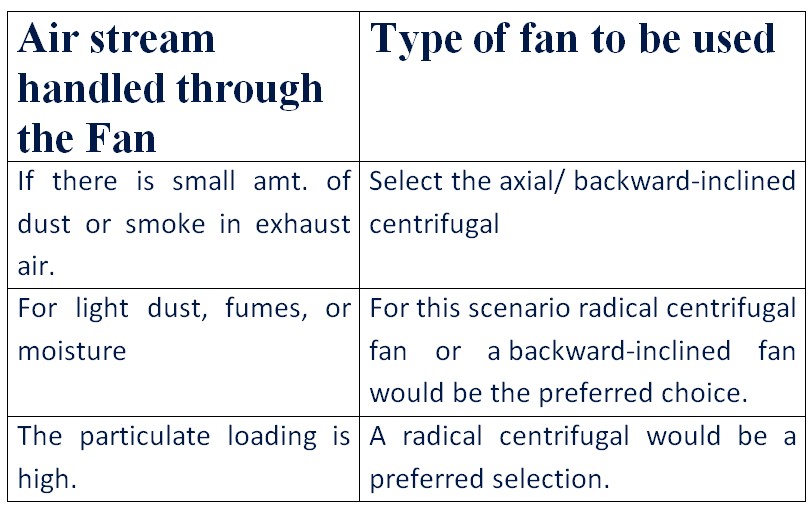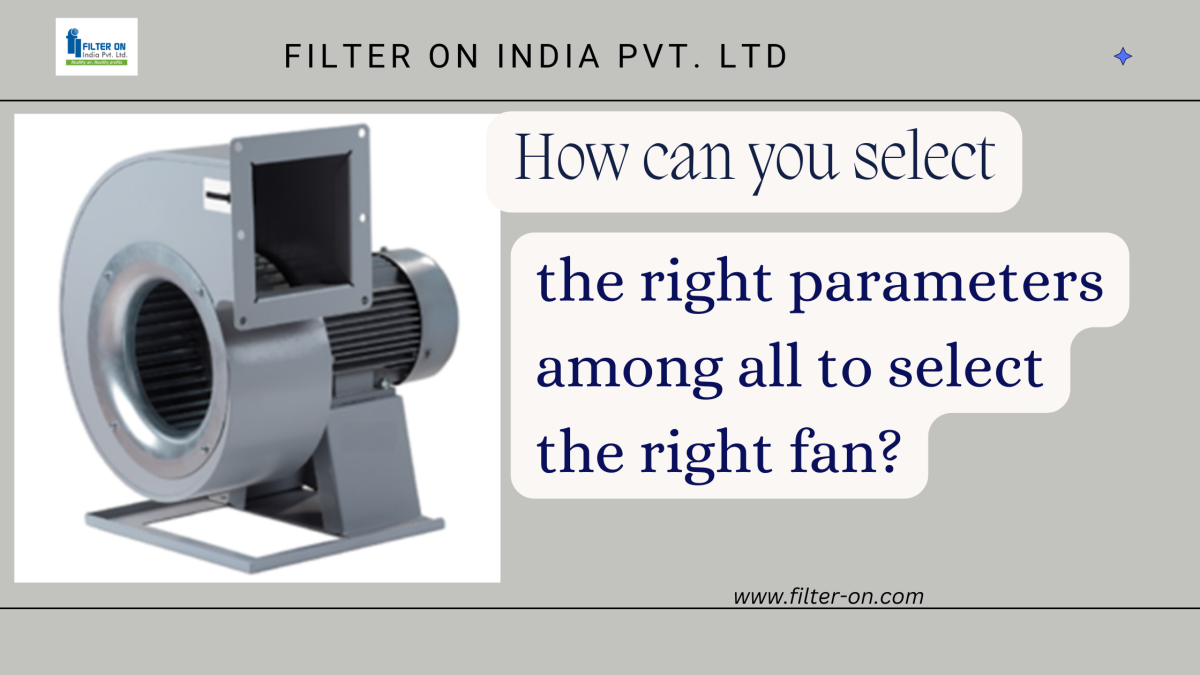Selecting the Right Fan for Enhanced Air Quality: Part II - Key Parameters to Consider
- filterontest
- May 17, 2024
- 3:17 pm
- 2 Comments
In our previous article, we discussed types of fans and recommendations for choosing the right fan selection for the right application. When we need to consider selecting the right fan for enhanced air quality, some key and important parameters need to be taken into consideration, We will discuss here the key parameters for selecting the right fan for enhanced air quality as well as explore more about configurations and types of drives for fans, which have a significant impact on the performance of the system as a whole.
Selecting the right fan: List of Key Parameters:
For enhanced air quality, we considered the key parameters for selecting the right fan, which are listed below.
Capacity:
Capacity involves flow rate based on actual cubic feet per minute (acfm) to the fan inlet.The water gauge measures flow rate and pressure requirements at standard conditions (0.075 Ibm/ftl) using FTP and FSP. If the required pressure is unknown under non-standard conditions, density correction is made to ensure accurate measurements.
- Air stream Handled Through the Fan
- Explosive or flammable material
- Corrosive Applications
- Elevated air stream temperatures
Air stream handled through the fan:
It involves the following:

Explosive or Flammable Material:
Always use spark resistant construction (use explosion proof motor if motor is in air stream. Always stick to the standards set by the National Board of Fire Underwriters, the National Fire Protection Association, and governmental regulations.
Corrosive Applications:
It may require a protective coating or special materials of construction (stainless, fiberglass)
Elevated Air Stream Temperatures:
Use the correct materials for construction, arrangement, and bearing types because the maximum operating temperature affects the strength of the materials.
Physical Limitations:
Physical limitations must be considered in fan selection. Fan size, inlet size and location, fan weight, and ease of maintenance are the important things to be considered along with performance requirements.The most efficient fan size may not fit in the available physical space.
Drive Arrangements:
In a packaged fan system, the drive arrangement, i.e., the motor, is provided by the manufacturer, but if you purchase an assembled unit, then you must make drive arrangements according to the motor type, such as:
- Direct Drive
- Belt Drive
Direct Drive provides a compact assembly with constant fan speeds, ensuring optimal motor performance despite variations in impeller geometry and motor speed.
Belt drive offers flexibility in fan speed. This can be done by altering the drive ratio. Some applications need flexibility in fan speed because it requires changes in system capacity or pressure requirements due to changes in process, hood design, equipment location, or air cleaning equipment.
Noise
Fan noise, generated by turbulence within the fan housing, varies by fan type, flow rate, pressure, and fan efficiency. Noise ratings must be obtained from the fan manufacturer, as each fan design is different. Most fans produce a "white" noise, a mixture of all frequencies, and radial blade fans also produce a pure tone at a frequency equal to the blade passage frequency (BPF). The backward inclined impeller design is generally the quietest, but non-uniform air flow at the fan inlet or outlet can increase fan noise level. Most fan manufacturers publish sound ratings, such as sound power levels for eight ANSI standard octave bands in decibels (dB). The surrounding environment affects the sound level, and the decibel unit is not interchangeable for sound power or sound pressure. Sound pressure levels are usually measured in dB using the "A" weighting scale, which closely reflects the human auditory response to noise of various frequencies.
Safety and Accessories:
Safety guards are required as per the latest government norms implemented everywhere. All the danger points, such as the inlet, outlet, shaft, drive, and cleanout doors, must be checked as per the safety guidelines. Accessories can help with installation as well as maintenance requirements. Examples of accessories include drains, cleanout doors, split housings, and shaft seals.
Flow Control:
To control the airflow of a fan, there are some accessories to be installed, such as dampers, variable-pitch blades, and speed control.
Dampers:
Dampers are part of the air stream so they are installed directly on the fan inlet or outlet. Dampers are made up of material, which may not be acceptable for material handling fans.
Advantages of Dampers:
- Dramatic Power Supply and Noise Reduction
- Simple installation.
- Lower initial costs.
Dampers are of two types:
Outlet Dampers:
The selection of outlet dampers depends on the required resistance, with parallel and opposed blades available for optimal control.
Inlet Dampers:
Inlet dampers reduce fan output and operating horsepower by pre-spinning air into the fan inlet, ensuring power savings for extended periods of operation.
Variable Pitch Blades:
Variable-pitch impellers enable manual or automatic changes to blade pitch, allowing for pneumatic or hydraulic adjustments while the fan is operating.
Variable Frequency Drive (VFD)
In flow control, a VFD (variable frequency drive) is also used as an accessory to control the flow of a fan, so the VFD is also an important parameter in fan selection.VFD applications vary fan speed and fan static pressure by controlling voltage and frequency between the electric power source and fan motor. The fan speed varies linearly with line frequency, with most VFD applications using direct drive arrangements. Belt drives are occasionally used.
VFD's intended usage requires understanding of the building's power supply and other electrical equipment usage. In applications with 80% or more system air flow, an inlet damper may be a better choice.
In short, the following parameters are more important in selecting the right fan:
When we think about a clean air system, there are numerous factors to be considered for optimal performance of the system. The selection of fans is one of them. Here are some factors responsible for these fan selections:.
Volume Flow Rate:
Make sure the fan has sufficiently high air speed and air flow for optimal performance of the system.
Pressure:
The amount of pressure needed to move air through the ducting and any filters,dampers, or other obstructions in the ventilation system.
Type of Air stream Handled:
The type of air that needs to be moved.
Space Limitations:
Available amount of space for the fan.
Efficiency:
The fan’s efficiency depends on the design and type of fan.
All the above factors are most important in selecting the right fan or blower for the clean air system.
How can you select the right parameters among all to select the right fan?
With so many deciding factors and parameters, how can one choose the right parameters to choose the right fan for a clean air system? Here, Filter On’s expert guidance came into play. Filter On assesses requirements and gives you expert guidance to choose the right fan for a clean air system.
Filter On will assess:
- Statically and dynamically balanced fans, optimized with careful selection of operating points.
- Optimal VFD ensures further power savings.
- Fans are selected for optimized performance and require less power.
Thus, Filter On uses their 40+ years of expertise to help you decide the right fan for a clean air system.
In the next article we will explore more about fine tuning of fans for optimum performance of the system.
Filter On India has been working towards “Mission Zero Pollution” for the last 40+ years as a clean air solutions partner for industries. We specialize and have expertise in welding fumes, oil mist, coolant mist, dust collection, soldering, laser marking, laser cutting, plasma cutting, fumes in fastener manufacturing, ball point tip manufacturing, oil quenching, kitchen fumes, etc. Filter On has 70+ clean air solutions, so you can contact us for more information about our solutions. You can reach us through the web or visit us at our corporate office at Pune and our virtual locations at Delhi, Bangalore, Ahmadabad, Hyderabad, or Chennai locations.







